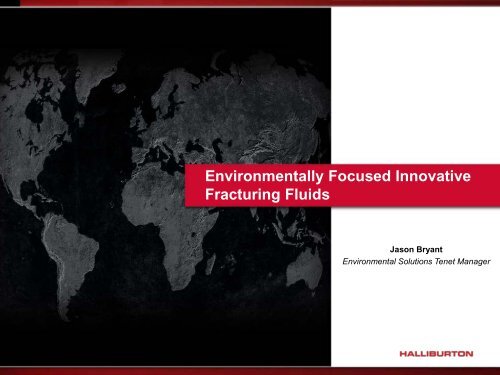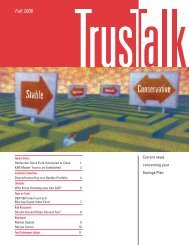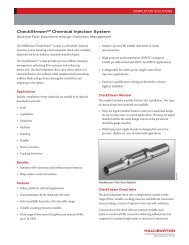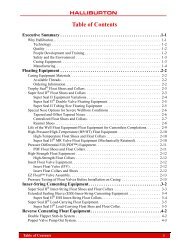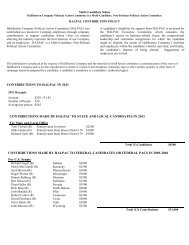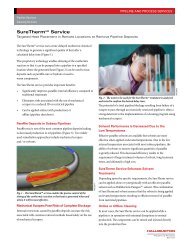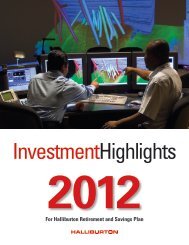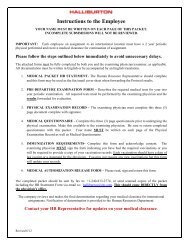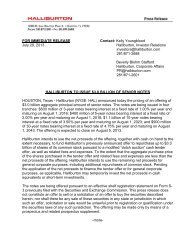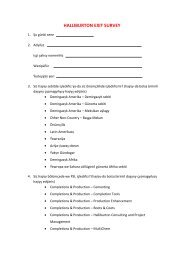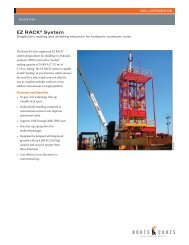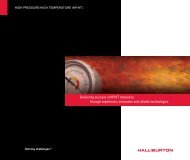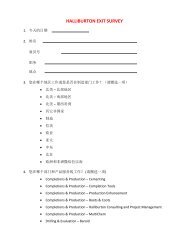Presentation - Halliburton
Presentation - Halliburton
Presentation - Halliburton
Create successful ePaper yourself
Turn your PDF publications into a flip-book with our unique Google optimized e-Paper software.
Environmentally Focused Innovative<br />
Fracturing Fluids<br />
Jason Bryant<br />
Environmental Solutions Tenet Manager
Hydraulic Fracturing…. in the Spotlight<br />
© 2012 HALLIBURTON. ALL RIGHTS RESERVED.<br />
2<br />
circa April 2011
EPA's study of hydraulic fracturing and its potential<br />
impact on drinking water resources<br />
• At the request of Congress, EPA is conducting a study to better<br />
understand any potential impacts of hydraulic fracturing on drinking<br />
water and ground water. The scope of the research includes the full<br />
lifespan of water in hydraulic fracturing, from acquisition of the water,<br />
through the mixing of chemicals and actual fracturing, to the postfracturing<br />
stage, including the management of flowback and<br />
produced water and its ultimate treatment and disposal.<br />
• A first report on the study will be released for peer review in late<br />
2012. Certain portions of the research will be released for peer<br />
review in 2014.<br />
© 2012 HALLIBURTON. ALL RIGHTS RESERVED.<br />
3
EPA to Investigate Effects of Hydraulic Fracturing<br />
• Natural gas plays a key role in our nation's clean energy future. The U.S. has<br />
vast reserves of natural gas that are commercially viable as a result of<br />
advances in horizontal drilling and hydraulic fracturing technologies enabling<br />
greater access to gas in shale formations. Responsible development of<br />
America's shale gas resources offers important economic, energy security,<br />
and environmental benefits.<br />
• EPA is working with states and other key stakeholders to help ensure that<br />
natural gas extraction does not come at the expense of public health and the<br />
environment. The Agency's focus and obligations under the law are to<br />
provide oversight, guidance and, where appropriate, rulemaking that achieve<br />
the best possible protections for the air, water and land where Americans live,<br />
work and play. The Agency is investing in improving our scientific<br />
understanding of hydraulic fracturing, providing regulatory clarity with respect<br />
to existing laws, and using existing authorities where appropriate to enhance<br />
health and environmental safeguards.<br />
© 2012 HALLIBURTON. ALL RIGHTS RESERVED.<br />
4
EPA's study of hydraulic fracturing and its potential<br />
impact on drinking water resources<br />
http://www.epa.gov/hfstudy/HF_Study__Plan_110211_FINAL_508.pdf<br />
© 2012 HALLIBURTON. ALL RIGHTS RESERVED.<br />
5
EPA's study of hydraulic fracturing and its potential<br />
impact on drinking water resources<br />
100% Water Recycle<br />
http://www.epa.gov/hfstudy/HF_Study__Plan_110211_FINAL_508.pdf<br />
© 2012 HALLIBURTON. ALL RIGHTS RESERVED.<br />
6
EPA's study of hydraulic fracturing and its potential<br />
impact on drinking water resources<br />
100% Water Recycle<br />
http://www.epa.gov/hfstudy/HF_Study__Plan_110211_FINAL_508.pdf<br />
Environmental Chemicals<br />
© 2012 HALLIBURTON. ALL RIGHTS RESERVED.<br />
7
Frac Fluid Composition<br />
*Image: EnergyinDepth.org 2009 Source: Compiled<br />
from Data collected at a Fayetteville Shale Fracture<br />
Stimulation by ALL Consulting 2008.<br />
Environmental Chemicals 100% Water Recycle<br />
© 2012 HALLIBURTON. ALL RIGHTS RESERVED.<br />
8
Large Amounts of Water<br />
55%<br />
28%<br />
Wood, Ruth et al. Shale Gas: A Provisional Assessment of Climate Change and Environmental Impacts.<br />
January 2011. New York State (2009) Supplemental generic environmental impact statement on the oil,<br />
gas and solution mining regulatory program’ by the New York State Department of Environmental<br />
Conservation Division of Mineral Resources.<br />
Environmental Chemicals 100% Water Recycle<br />
© 2012 HALLIBURTON. ALL RIGHTS RESERVED.<br />
9
Large Amounts of Water<br />
Environmental Chemicals 100% Water Recycle<br />
© 2012 HALLIBURTON. ALL RIGHTS RESERVED.<br />
10
Water Management: Field-Scale Issue<br />
Water Needed vs. Produced<br />
per Well in Field’s Completion Program<br />
• Municipal Fresh Water<br />
• Surface Waters<br />
– Rivers<br />
– Lakes<br />
– Sea water<br />
• Ground Water<br />
– Aquifers<br />
– Water sheds<br />
• Waste water<br />
– Municipal<br />
– AMD<br />
Environmental Chemicals 100% Water Recycle<br />
© 2012 HALLIBURTON. ALL RIGHTS RESERVED.<br />
11
Handling Flowback / Produced Water (FBPW)<br />
1) Use<br />
Processed<br />
Water<br />
2) Use<br />
Unprocessed<br />
Water<br />
FBPW<br />
FBPW<br />
Process<br />
Develop<br />
Frac<br />
Fluid<br />
Waste<br />
Clean<br />
Water<br />
Frac Fluid<br />
FBPW<br />
Environmental Chemicals 100% Water Recycle<br />
© 2012 HALLIBURTON. ALL RIGHTS RESERVED.<br />
12
Flowback and Produced Water Variability<br />
Sample #1 #2 #3 #4 #5 #6 #7 #8 #9<br />
Specific gravity 1.026 1.036 1.019 1.012 1.070 1.100 1.170 1.105 1.066<br />
pH 7.92 7.51 7.91 6.61 6.72 6.68 6.05 7.11 7.04<br />
Ionic Strength 0.59 0.881 0.319 0.199 1.919 2.794 4.96 2.874 1.754<br />
Hydroxide (mpL) 0 0 0 0 0 0 0 0 0<br />
Carbonate (mpL) 0 0 0 0 0 0 0 0 0<br />
Bicarbonate (mpL) 1,010 717 1190 259 183 183 76 366 366<br />
Chloride (mpL) 19,400 29,400 10,000 6,290 59,700 87,700 153,000 96,400 58,300<br />
Sulfate (mpL) 34 0 88 67 0 0 0 670 749<br />
Calcium (mpL) 630 1,058 294 476 7,283 10,210 20,100 4,131 2,573<br />
Magnesium (mpL) 199 265 145 49.6 599 840 1,690 544 344.0<br />
Barium (mpL) 49.4 94.8 6.42 6.24 278 213 657 1.06 5.1<br />
Strontium (mpL) 107 179 44.7 74.3 2,087 2,353 5,049 178 112<br />
Total Iron (mpL) 4.73 25.7 8.03 14 27.4 2.89 67.6 26.4 33.8<br />
Aluminum (mpL) 0.17 0.21 0.91 0.38 0.18 0 0.1 0.17 0.78<br />
Boron (mpL) 28.2 27.1 26.7 8.82 45.1 73.1 80.4 94.5 65.7<br />
Potassium (mpL) 192 273 78.7 85.8 977 1,559 2,273 2,232 1,439<br />
Sodium (mpL) 10,960 16,450 5,985 3,261 26,780 39,990 61,400 54,690 32,600<br />
TDS (mpL) 33,300 49,300 18,200 10,800 98,600 144,000 252,000 160,000 97,700<br />
TSS (mpL) 57 246 50 30 10 12 32 120 13,762<br />
TOC (mpL) 89 64 133 180 218 70 143 266 235<br />
Environmental Chemicals 100% Water Recycle<br />
© 2012 HALLIBURTON. ALL RIGHTS RESERVED.<br />
13
Fracturing Fluids with Produced Waters<br />
• Friction Reducers<br />
– Minimize pipe friction, surface<br />
treating pressure and horsepower<br />
– Maximize rate and bottom hole<br />
treating pressure<br />
– Impacts: poor sustained friction<br />
reduction performance and higher<br />
scaling tendencies<br />
• Crosslinked Fluids<br />
– Minimize pipe friction, surface<br />
treating pressure and horsepower<br />
– Adequate fracture width, proppant<br />
placement, and fracture cleanup<br />
– Impacts: high friction, screenouts,<br />
low conductivity, and higher<br />
scaling tendencies<br />
Courtesy of the Flow Assurance and Scale Team (FAST) JIP at Heriot-Watt and Leeds Universities<br />
Environmental Chemicals 100% Water Recycle<br />
© 2012 HALLIBURTON. ALL RIGHTS RESERVED.<br />
14
Will a High TDS Fluid Damage my Well?<br />
Na +<br />
K + (if not known =0)<br />
Mg 2+<br />
Ca 2+<br />
Sr 2+<br />
Ba 2+<br />
Fe 2+<br />
Cl -<br />
SO<br />
4 2-<br />
Alkalinity**<br />
TDS (Measured)<br />
Calc. Density (STP)<br />
pH, measured (STP)<br />
(mg/l)<br />
(mg/l)<br />
(mg/l)<br />
(mg/l)<br />
(mg/l)<br />
(mg/l)<br />
(mg/l)<br />
(mg/l)<br />
(mg/l)<br />
(mg/l)<br />
(mg/l)<br />
(g/ml)<br />
pH<br />
Brine 1<br />
54,690<br />
2,232<br />
544<br />
4,131<br />
178<br />
1<br />
26<br />
96,400<br />
670<br />
366<br />
160,000<br />
1.100<br />
7.11<br />
Brine 2<br />
61,400<br />
2,273<br />
1,690<br />
20,100<br />
5,049<br />
657<br />
68<br />
153,000<br />
0<br />
76<br />
252,000<br />
1.157<br />
6.05<br />
Brine 3<br />
10,960<br />
192<br />
199<br />
630<br />
107<br />
49<br />
5<br />
19,400<br />
34<br />
1,010<br />
33,300<br />
1.020<br />
7.92<br />
Brine 4<br />
39,990<br />
977<br />
840<br />
10,210<br />
2,353<br />
213<br />
3<br />
87,700<br />
0<br />
183<br />
144,000<br />
1.093<br />
6.68<br />
Reference Municipal<br />
Water<br />
40<br />
7<br />
25<br />
37<br />
1<br />
0<br />
0<br />
47<br />
118<br />
162<br />
440<br />
0.997<br />
7.41<br />
Environmental Chemicals 100% Water Recycle<br />
© 2012 HALLIBURTON. ALL RIGHTS RESERVED.<br />
15
Scaling Tendencies<br />
Potential Scale (lb/1,000bbl)<br />
160<br />
140<br />
120<br />
100<br />
80<br />
60<br />
40<br />
20<br />
0<br />
Bakken Marcellus 1 Woodford Marcellus 2<br />
Brine 1 Brine 2 Brine 3 Brine 4<br />
Siderite<br />
Barite<br />
Calcite<br />
(FeCO 3 )<br />
(BaSO 4 )<br />
(CaCO 3 )<br />
Environmental Chemicals 100% Water Recycle<br />
© 2012 HALLIBURTON. ALL RIGHTS RESERVED.<br />
16
Potential Scale (lb/1,000bbl)<br />
If You Mix With The Wrong Water…<br />
(50/50 with reference tap water)<br />
160<br />
140<br />
120<br />
100<br />
80<br />
60<br />
40<br />
20<br />
0<br />
Brine 1 Brine 1<br />
+<br />
Brine 2 Brine 2<br />
+<br />
Brine 3 Brine 3<br />
+<br />
Brine 4 Brine 4<br />
+<br />
reference<br />
reference<br />
reference<br />
reference<br />
municipal<br />
municipal<br />
municipal<br />
municipal<br />
water<br />
water<br />
water<br />
water<br />
Celestite<br />
Anhydrite<br />
Siderite<br />
Barite<br />
Calcite<br />
(SrSO 4 )<br />
(CaSO 4 )<br />
(FeCO 3 )<br />
(BaSO 4 )<br />
(CaCO 3 )<br />
Environmental Chemicals 100% Water Recycle<br />
© 2012 HALLIBURTON. ALL RIGHTS RESERVED.<br />
17
Friction Reducers: Effects of Ca 2+ on Standard FRs<br />
% Friction Reduction<br />
-20<br />
-10<br />
0<br />
10<br />
20<br />
30<br />
40<br />
50<br />
60<br />
70<br />
80<br />
90<br />
100<br />
ppm Calcium<br />
0<br />
0 2 4 6 8 10 12 14 16 18<br />
Time (minutes)<br />
Environmental Chemicals 100% Water Recycle<br />
© 2012 HALLIBURTON. ALL RIGHTS RESERVED.<br />
18
Friction Reducers: Effects of Ca 2+ on Standard FRs<br />
% Friction Reduction<br />
-20<br />
-10<br />
0<br />
10<br />
20<br />
30<br />
40<br />
50<br />
60<br />
70<br />
80<br />
90<br />
100<br />
ppm Calcium<br />
0<br />
50<br />
100<br />
200<br />
400<br />
600<br />
1000<br />
1500<br />
2000<br />
0 2 4 6 8 10 12 14 16 18<br />
Time (minutes)<br />
Environmental Chemicals 100% Water Recycle<br />
© 2012 HALLIBURTON. ALL RIGHTS RESERVED.<br />
19
Friction Reducers: Effects of Ca 2+ on Standard FRs<br />
% Friction Reduction<br />
-20<br />
-10<br />
0<br />
10<br />
20<br />
30<br />
40<br />
50<br />
60<br />
70<br />
80<br />
90<br />
100<br />
% Reduction vs. Time in 1/2-in Smooth Pipe<br />
Looking at effects of Ca 2+ on 2.5 lb/Mgal of Anionic FR<br />
ppm Calcium<br />
0<br />
50<br />
100<br />
200<br />
400<br />
600<br />
1000<br />
1500<br />
2000<br />
4000<br />
10,000<br />
16,000<br />
22,000<br />
27,500<br />
34,000<br />
43,300<br />
52,400<br />
0 2 4 6 8 10 12 14 16 18<br />
Time (minutes)<br />
Environmental Chemicals 100% Water Recycle<br />
© 2012 HALLIBURTON. ALL RIGHTS RESERVED.<br />
20
Time-Average % Friction Reduction<br />
100<br />
90<br />
80<br />
70<br />
60<br />
50<br />
40<br />
30<br />
20<br />
10<br />
Friction Reducers: Effects of Other Constituents on<br />
Standard FRs<br />
0<br />
TDS = 10,800 mpl;<br />
TH = 600 mpl<br />
TDS = 17,700 mpl;<br />
TH = 500 mpl<br />
TDS = 33,300 mpl;<br />
TH = 1000 mpl<br />
TDS = 98,600 mpl;<br />
TH = 10,200 mpl<br />
TDS = 144,000 mpl;<br />
TH = 13,600 mpl<br />
TDS = 166,000 mpl; TDS = 252,000 mpl;<br />
TH = 4,900 mpl TH = 27,500 mpl<br />
1-Minute<br />
4-Minutes<br />
25-Minutes<br />
Lines:<br />
1 gpt<br />
Anionic FR<br />
in Fresh<br />
Water, the<br />
benchmark<br />
Environmental Chemicals 100% Water Recycle<br />
© 2012 HALLIBURTON. ALL RIGHTS RESERVED.<br />
21
Friction Reducers: Salt-Tolerant Friction Reducers<br />
FR-98, 0.1 gpt MC B-8642, 0.2 gpt MC 5-2510T,<br />
0.5 gpt Lo-Surf 300<br />
FR-98<br />
>200,000 mpl TDS water<br />
Environmental Chemicals 100% Water Recycle<br />
© 2012 HALLIBURTON. ALL RIGHTS RESERVED.<br />
22
Friction Reducers: Salt-Tolerant Friction Reducers<br />
Suite of Friction Reducers<br />
Enables 100% Produced Water reuse<br />
Maintains Freshwater Performance<br />
Tolerant of high levels of multivalent cations<br />
Tolerant of a variety of unknown contaminants<br />
Friction Reducer<br />
TDS (mpl)<br />
FR-78 50,000 to 100,000<br />
FR-88 100,000 to 200,000<br />
FR-98 More than 200,000<br />
Field Trial: FR-98 in 250,000 mpl TDS Water, 100 bpm, 4.5-in. casing<br />
Environmental Chemicals 100% Water Recycle<br />
© 2012 HALLIBURTON. ALL RIGHTS RESERVED.<br />
23
Crosslinked Fluids: Behavior in Produced Water<br />
Viscosity / cp @ 40 s -1<br />
2000<br />
1800<br />
1600<br />
1400<br />
1200<br />
1000<br />
800<br />
600<br />
400<br />
200<br />
0<br />
Mixed Water (80 Fresh: 20 Produced)<br />
Original Formula<br />
0 10 20 30 40 50 60 70 80 90<br />
Time / min<br />
100% fresh water<br />
Original Formula<br />
Mixed Water (80 Fresh: 20 Produced)<br />
Modified Formula<br />
250<br />
200<br />
150<br />
100<br />
50<br />
0<br />
Temperature / F<br />
Environmental Chemicals 100% Water Recycle<br />
© 2012 HALLIBURTON. ALL RIGHTS RESERVED.<br />
24
Summary: 100% Water Recycling<br />
• Scale Program is essential<br />
–Standard water analysis for all waters<br />
–Formation, Fracturing, and Production conditions<br />
–Scale Inhibitors may be necessary<br />
• Friction Reducers<br />
–FR-78, FR-88, FR-98<br />
–Enables 100% Produced Water reuse<br />
–TDS > 200,000 mpl<br />
• Crosslinked Fluids<br />
–100% Produced Water reuse requires formulation<br />
adjustments<br />
–Fracturing Fluid Knowledge: crosslinking and<br />
breaking<br />
Environmental Chemicals 100% Water Recycle<br />
© 2012 HALLIBURTON. ALL RIGHTS RESERVED.<br />
25
Groundwater Contamination: Effects from Hydraulic<br />
Fracturing Fluids<br />
Wood, Ruth et al. Shale Gas: A Provisional Assessment of Climate Change and Environmental Impacts. January 2011.<br />
US EPA Hydraulic Fracturing Research Study – Scoping Backgrounder, 2010.<br />
State Oil and Gas Regulations Designed to Protect Water Resources – Groundwater protection Council, US Dept. of Energy,<br />
National Energy Technology Laboratory May 2009<br />
© 2012 HALLIBURTON. ALL RIGHTS RESERVED.<br />
26
Groundwater Contamination: Effects from Hydraulic<br />
Fracturing Fluids<br />
The API study analysed the risk of contamination from properly constructed<br />
Class II injection wells to an Underground Source of Drinking Water<br />
(USDW) due to corrosion of the casing and failure of the casing cement<br />
seal. Using this, the ICF study (and New York State, 2009) identified that<br />
the “probability of fracture fluids reaching a USDW due to failures in the<br />
casing or casing cement is estimated at less than 2 x 10-8 (fewer than 1 in<br />
50million wells)”. On this basis the ICF study concludes that “hydraulic<br />
fracturing does not present a reasonably foreseeable risk of significant<br />
adverse environmental impacts to potential freshwater aquifers”<br />
Wood, Ruth et al. Shale Gas: A Provisional Assessment of Climate Change and Environmental Impacts. January 2011.<br />
New York State (2009) Supplemental generic environmental impact statement on the oil, gas and solution mining regulatory<br />
program’ by the New York State Department of Environmental Conservation Division of Mineral Resources.<br />
© 2012 HALLIBURTON. ALL RIGHTS RESERVED.<br />
27
Green Technologies: Fracturing Fluid Chemistries<br />
Chemical Group<br />
Gelling Agent<br />
Hydration Aid<br />
Biocide<br />
Crosslinker<br />
Breaker<br />
Surfactant<br />
Function<br />
Reduce friction, Fluid viscosity modification<br />
Control bacteria growth; Fracturing Fluid integrity<br />
and Formation health<br />
Increase Fracturing Fluid viscoelasticity; Proppant<br />
transport and distribution<br />
Reduce Fracturing Fluid viscoelasticity and viscosity;<br />
Fracture cleanup<br />
Enhance hydrocarbon recovery<br />
© 2012 HALLIBURTON. ALL RIGHTS RESERVED.<br />
28
Green Technologies: Fracturing Fluid Chemistries<br />
100% Water Recycle<br />
http://www.halliburton.com/public/projects/pubsdata/Hydraulic_Fracturing/fluids_disclosure.html<br />
© 2012 HALLIBURTON. ALL RIGHTS RESERVED.<br />
29<br />
Environmental Chemicals
̶<br />
̶<br />
̶<br />
̶<br />
̶<br />
̶<br />
̶<br />
̶<br />
̶<br />
̶<br />
̶<br />
Green Technologies: Advanced Dry Polymer (ADP)<br />
Blender<br />
• Batch Hydration: Solids (50’s)<br />
Hydration in Hours<br />
Tedious, Time-Consuming Operation<br />
Requires Large Physical Footprint<br />
Susceptible to Bacteria Contamination<br />
• On-the-Fly: LGC’s (70’s)<br />
Hydration in seconds<br />
(70’s) Aqueous Carriers; 15% active<br />
(80’s) Hydrocarbon Carriers; 50% active<br />
Diesel; BETX<br />
• On-the-Fly with Solids (00’s)<br />
Hydration in Seconds<br />
High-Energy Fluid Shearing Device<br />
Capable of High Throughput Rates<br />
100% Water Recycle<br />
Environmental Chemicals<br />
© 2012 HALLIBURTON. ALL RIGHTS RESERVED.<br />
30
̶<br />
̶<br />
̶<br />
̶<br />
̶<br />
̶<br />
Green Technologies: CleanStream ® Service<br />
DNA before exposure<br />
DNA after exposure<br />
• Ultraviolet (UV) Light reduces<br />
and controls bacteria levels<br />
Damages Bacteria DNA<br />
Renders Bacteria Sterile<br />
Viable Bacteria are Reduced by<br />
99.99%<br />
• UV Reduces Chemical<br />
Biocides<br />
Many Applications are Biocide-Free<br />
• UV is Field Tested and<br />
Proven<br />
High Throughput Rates<br />
Various Water Qualities and<br />
Turbidities<br />
100% Water Recycle<br />
Environmental Chemicals<br />
© 2012 HALLIBURTON. ALL RIGHTS RESERVED.<br />
31
Green Technologies: CleanStim ® Hydraulic Fracturing<br />
Fluid System<br />
Enzyme<br />
Constituent<br />
Exthoxylated Sugar-Based<br />
Fatty Acid Ester<br />
Inorganic Acid<br />
Inorganic Salt<br />
Maltodextrin<br />
Organic Acid<br />
Organic Ester<br />
Partially Hydrogenated<br />
Vegetable Oil<br />
Polysaccharide Polymer<br />
Sulfonated Alcohol<br />
Common Uses<br />
Soybean Paste, Fruit Juices and Nectars, Laundry Detergent, Dishwasher<br />
Detergent, Toilet Cleaner, Industrial Pulp and Paper Processing Aid<br />
Synthetic Food Flavoring Substance, Natural Baby Wipes, Baby Wash and<br />
Shampoo<br />
Cheese, Alcoholic Beverages, Wheel Cleaner, Rust Dissolver, Dishwashing<br />
Detergent<br />
Food Starch – Modified, Water Clarifier, Fish Tank Water Treatment<br />
Sweetener, Glaze and Icing Sugar, Coconut Milk and Coconut Cream,<br />
Shower Gel<br />
Fruit Juice, Dishwasher Cleaner, All-Purpose Cleaner, Hand Soap<br />
Liquid Egg Products, Food Resinous and Polymeric Coatings, Hairspray<br />
Confectionary Chocolate Coating, Hair Detangler, Body Lotion, Lip Liner,<br />
Soap, Lotion, Cream and Other Skin Care Formulations<br />
Canned Fish, Processed Cheese, Dairy-Based Desserts and Drinks, Beer,<br />
Toothpaste<br />
Egg White Solids, Marshmallows, Dishwashing Liquid, Home Dilutable<br />
Cleaner, Shampoo, Acne Scrub, Shaving Cream, Liquid Hand Soap<br />
100% Water Recycle<br />
Environmental Chemicals<br />
© 2012 HALLIBURTON. ALL RIGHTS RESERVED.<br />
32
Green Technologies: CleanStim ® Hydraulic Fracturing<br />
Fluid System<br />
Component<br />
CleanWG<br />
CleanLink<br />
CleanSurf<br />
CleanBreak E<br />
Function<br />
Polysaccharide gelling agent<br />
Crosslinker<br />
Surfactant<br />
Conventional enzyme<br />
100% Water Recycle<br />
CleanBreak CRE<br />
CleanBreak LT<br />
CleanBreak MT<br />
CleanBreak HT<br />
CleanBreak XT<br />
Controlled-release enzyme<br />
Encapsulated Breaker<br />
Triggered-release breaker<br />
Triggered-release breaker<br />
Breaker<br />
Environmental Chemicals<br />
© 2012 HALLIBURTON. ALL RIGHTS RESERVED.<br />
33
Green Technologies: CleanStim ® Hydraulic Fracturing<br />
Fluid System<br />
Base Gel Hydration<br />
100% Water Recycle<br />
Environmental Chemicals<br />
© 2012 HALLIBURTON. ALL RIGHTS RESERVED.<br />
34
Green Technologies: CleanStim ® Hydraulic Fracturing<br />
Fluid System<br />
Crosslinked Fluid Rheology<br />
100% Water Recycle<br />
Environmental Chemicals<br />
© 2012 HALLIBURTON. ALL RIGHTS RESERVED.<br />
35
Green Technologies: CleanStim ® Hydraulic Fracturing<br />
Fluid System<br />
Crosslinked Fluid Rheology<br />
Environmental Chemicals<br />
100% Water Recycle<br />
© 2012 HALLIBURTON. ALL RIGHTS RESERVED.<br />
36
Green Technologies: CleanStim ® Hydraulic Fracturing<br />
Fluid System<br />
Crosslinked Fluid Rheology<br />
100% Water Recycle<br />
Environmental Chemicals<br />
© 2012 HALLIBURTON. ALL RIGHTS RESERVED.<br />
37
Green Technologies: CleanStim ® Hydraulic Fracturing<br />
Fluid System<br />
Broken Gel Comparison<br />
100% Water Recycle<br />
CleanStim ®<br />
60 lb/1000gal<br />
Guar-Borate<br />
25 lb/1000gal<br />
Both gels broken with enzyme breakers<br />
Environmental Chemicals<br />
© 2012 HALLIBURTON. ALL RIGHTS RESERVED.<br />
38
Green Technologies: CleanStim ® Hydraulic Fracturing<br />
Fluid System<br />
% Regain Conductivity<br />
120<br />
100<br />
80<br />
60<br />
40<br />
20<br />
0<br />
Regained Conductivity<br />
CleanStim Fracturing Fluid Regain Conductivity with Breakers<br />
1 lb/ft 2 Ottawa Sand between Ohio Sandstone Cores; 2000 psi Closure Stress<br />
2% KCl before wet gas<br />
wet gas<br />
2% KCl after wet gas<br />
1.25 lb CleanBreak E 1.5 lb CleanBreak CRE 5 lb CleanBreak LT 10 lb CleanBreak MT 10 lb CleanBreak HT 1 gal CleanBreak XT 1 gal CleanBreak XT<br />
40 lb CleanWG 40 lb CleanWG 40 lb CleanWG 60 lb CleanWG 60 lb CleanWG 60 lb CleanWG 60 lb CleanWG<br />
120 °F 120 °F 120 °F 140 °F 160 °F 180 °F 200 °F<br />
Holtsclaw J., Loveless D., et al. Environmentally Focussed Crosslinked-Gel System Results in<br />
High Retained Proppant-Pack Conductivity. SPE 146832, ATCE, Denver 2011<br />
100% Water Recycle<br />
Environmental Chemicals<br />
© 2012 HALLIBURTON. ALL RIGHTS RESERVED.<br />
39
Green Technologies: CleanStim ® Hydraulic Fracturing<br />
Fluid System<br />
% Retained Conductivity<br />
110<br />
100<br />
90<br />
80<br />
70<br />
60<br />
50<br />
40<br />
30<br />
20<br />
10<br />
0<br />
2000 psi (0 h)<br />
2000 psi (10 h)<br />
200 °F<br />
140 °F<br />
120 °F<br />
2 mL/min<br />
flow<br />
2000 psi (15 h)<br />
2000 psi (20 h)<br />
2000 psi (23 h) 10 mL/min<br />
Regained Conductivity, 3 rd Party<br />
2000 psi (24 h) 20 mL/min<br />
2000 psi (25 h) 25 mL/min<br />
Wet gas flow<br />
2000 psi (40 h) after wet gas<br />
2000 psi (50 h) after wet gas<br />
105%<br />
95%<br />
74%<br />
100% Water Recycle<br />
Environmental Chemicals<br />
© 2012 HALLIBURTON. ALL RIGHTS RESERVED.<br />
40
Green Technologies: CleanStim ® Hydraulic Fracturing<br />
Fluid System<br />
Xlinked gel<br />
Proppant Transport<br />
1 ppg 20/40 Ottawa<br />
100% Water Recycle<br />
5 ppg 20/40 Ottawa<br />
Xlinked gel after sand<br />
through system<br />
Loveless D., Holtsclaw J., et al. Fracturing Fluid Comprised of Components Sourced Solely from the<br />
Food Industry Provide Superior Proppant Transport. SPE 147206, ATCE, Denver 2011<br />
Environmental Chemicals<br />
© 2012 HALLIBURTON. ALL RIGHTS RESERVED.<br />
41
Green Technologies: CleanStim ® Hydraulic Fracturing<br />
Fluid System<br />
Proppant Transport<br />
100% Water Recycle<br />
SFI Gel<br />
Linear Gel<br />
VES Gel<br />
Environmental Chemicals<br />
© 2012 HALLIBURTON. ALL RIGHTS RESERVED.<br />
42
̶<br />
̶<br />
̶<br />
̶<br />
̶<br />
̶<br />
̶<br />
Green Technologies: CleanStim ® Hydraulic Fracturing<br />
Fluid System<br />
• The Challenges<br />
Vertical (multistage)<br />
Horizontal (multistage)<br />
17,000 ft MD; 12,000 ft TVD<br />
Shales<br />
Sandstones<br />
Gas reservoirs<br />
Oil reservoirs<br />
• 120 to 340 °F BHST<br />
• 20 to 80 bbl/min<br />
• 3.5 in tubing to 5.5 in casing<br />
• Up to 7 lb/gal sand<br />
• Good Results<br />
© 2012 HALLIBURTON. ALL RIGHTS RESERVED.<br />
Jobs To-Date<br />
Modeland N., Tomova I., et al. Using Enhanced Fracturing-Fluid Cleanup and Conductivity in the<br />
Hosston/Travis Peak Formation for Improved Production. SPE 150958, HFTC, The Woodlands 2012.<br />
43<br />
100% Water Recycle<br />
Environmental Chemicals
Fracturing Fluid Solutions for Your Water Concerns<br />
Provide Stimulation Solutions<br />
Resonates with the public<br />
Stays a step ahead of forthcoming regulations<br />
Provides greater enhancement efficiencies<br />
Fracturing Fluid Solution<br />
Suite of Salt-Tolerant Friction<br />
Reducers (FR-78, FR-88, FR-98)<br />
CleanStream ® Service<br />
Advanced Dry Polymer (ADP)<br />
Blender<br />
CleanStim ® Hydraulic Fracturing<br />
Fluid System<br />
Solving Challenges.<br />
Enables 100% Flowback/Produced<br />
without Treatment<br />
Reduces the Need for Chemical<br />
Bacteria Control<br />
Eliminates BETX Uncertainty with<br />
Gelling Agents<br />
Fracturing Fluid Formulation Made<br />
with Ingredients Sourced from the<br />
Food Industry<br />
© 2012 HALLIBURTON. ALL RIGHTS RESERVED.<br />
44
Fracturing Fluid Solutions for Your Water Concerns<br />
Provide Stimulation Solutions<br />
Resonates with the public<br />
Stays a step ahead of forthcoming regulations<br />
Provides greater production enhancement efficiencies<br />
Fracturing Fluid Solution<br />
Suite of Salt-Tolerant Friction<br />
Reducers (FR-78, FR-88, FR-98)<br />
CleanStream ® Service<br />
Advanced Dry Polymer (ADP)<br />
Blender<br />
CleanStim ® Hydraulic Fracturing<br />
Fluid System<br />
Solving Challenges.<br />
Enables 100% Flowback/Produced<br />
without Treatment<br />
Reduces the Need for Chemical<br />
Bacteria Control<br />
Eliminates BETX Uncertainty with<br />
Gelling Agents<br />
Fracturing Fluid Formulation Made<br />
with Ingredients Sourced from the<br />
Food Industry<br />
© 2012 HALLIBURTON. ALL RIGHTS RESERVED.<br />
45
On the Horizon… Air Quality<br />
Conventional resources generally exist in discrete, well-defined subsurface<br />
accumulations (reservoirs), with permeability values greater than a specified<br />
lower limit. Such conventional gas resources can usually be developed using<br />
vertical wells, and often yield economic recovery rates of more than 80% of<br />
the Gas Initially in Place (GIIP). By contrast, unconventional resources are<br />
found in accumulations where permeability is low. Such accumulations<br />
include “tight” sandstone formations, coal-beds, and shale formations.<br />
Unconventional resource accumulations tend to be distributed over a much<br />
larger area than conventional accumulations and usually require well<br />
stimulation in order to be economically productive; recovery factors are much<br />
lower — typically of the order of 15% to 30% of GIIP” (MIT, 2010).<br />
Wood, Ruth et al. Shale Gas: A Provisional Assessment of Climate Change and Environmental Impacts. January 2011.<br />
MIT (2010) The future of natural gas, an interdisciplinary study the Massachusetts Institute of Technology’s Energy Initiative<br />
ISBN (978-0-9828008-0-5 Copyright MIT 2010.<br />
© 2012 HALLIBURTON. ALL RIGHTS RESERVED.<br />
46
On the Horizon… Air Quality<br />
Wood, Ruth et al. Shale Gas: A Provisional Assessment of Climate Change and Environmental Impacts. January 2011.<br />
DUKES (2010), Digest of UK Energy Statistics, Annex A. Department for Energy and Climate Change, London.<br />
POST (2005), Cleaner Coal postnote 253. Parliamentary Office of Science and Technology.<br />
© 2012 HALLIBURTON. ALL RIGHTS RESERVED.<br />
47
On the Horizon…Air Quality<br />
Wood, Ruth et al. Shale Gas: A Provisional Assessment of Climate Change and Environmental Impacts. January 2011.<br />
© 2012 HALLIBURTON. ALL RIGHTS RESERVED.<br />
48


